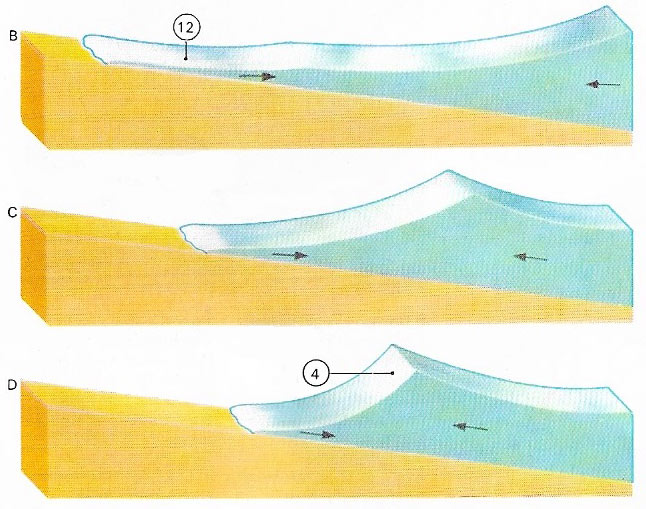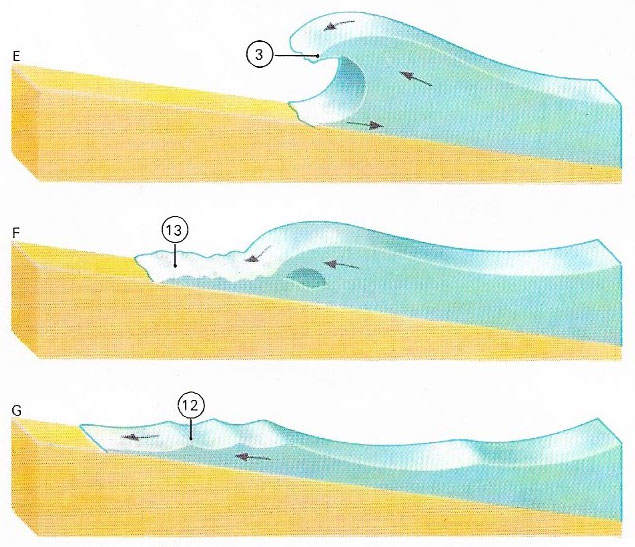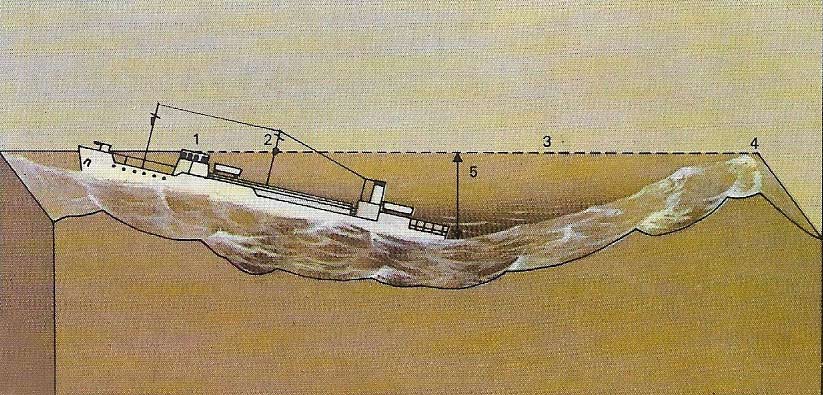ocean waves

Waves have height and length. The wavelength (14) is the distance between one crest (5) and another, in this case, a peaking wave (4).Between crests is a trough (1). The wave height (6)is the distance between the crest and the trough. If wave action ceased, the water would settle at the "still water level" (8). Wave action extends to the wave base (7). Wave distortion is caused by frictional drag on the bottom. If waves pass over a sand bar (10), a spilling breaker (9) may form. Sometimes, waves in shallow water move the whole body of the water forward in translation waves (2) toward the shore (1).


Figure 1. In the development of a breaking wave, B shows backwash (12). C shows the advance of the next wave which peaks (4) in D and then becomes a plunging breaker (3) in E. F and show swash (13) rushing up the beach after the wave has broken. Backwash the begins the cycle again.

Figure 2. The tallest recorded wave in open sea was 34 meters (112 feet) high. An officer on the USS Ramapo's bridge (1) in the Pacific in 1933 saw the crest of a wave (4) in line with the horizon (3) and the crow's nest (2), enabling him to work out the wave height (5).
Waves and tides are the most familiar features of oceans and seas. Some wave motion occurs at great depth along the boundary of two opposing currents. But most waves are caused by the wind blowing over an open stretch of water. This area where the wind blows is known as the "fetch". Waves there are confused and irregular and are referred to as a "sea". As they propagate beyond the fetch they combine into more orderly waves forming a swell which travels for large distances beyond the fetch. Waves are movements of oscillation –- that is, the shape of the wave moves across the water, but the water particles rotate in a circular orbit with hardly any lateral movement. As a result, if there is no wind or current, a corked bottle bobs up and down in the waves, but is more or less stationary.
Waves have two basic dimensions. Wave height is the vertical distance between the crest and the trough. Wavelength is the distance between two crests. At sea, waves seldom exceed 12 meters (39 feet) in height, although 34 meters (112 feet) high was observed in the Pacific in 1933 (Figure 2). Such a wave requires a long fetch measuring thousands of miles and high-speed winds. Wave motion continues for some way beneath the surface, but the rotating orbits diminish and become negligible at a depth of about half the wavelength; this is known as the wave base.
Waves that break along a seashore may have been generated by storms in mid-ocean or by local winds. As waves approach shallow water, which is defined as a depth of half a wavelength, their character changes. As a wave "feels" the bottom, it gradually slows down and the crests tend to crowd together. When the wave in front of a wave is insufficient to fill the wave form, the rotating orbit, and hence the wave, breaks. There are two main kinds of breakers. Spilling breakers occur on gently sloping beaches, when the crests spill over to form a mass of surface. Plunging breakers occur on steeper slopes (Figure 1).
Tsunamis
Tsunamis are sometimes called tidal waves but they have no connection with tides. Tsunamis are caused mainly by earthquakes, but also by submarine landslides and volcanic eruptions. At sea, the height of the wave is seldom more than 60–90 centimeters (2–3 feet). But the wavelength may be hundreds of miles long and tsunamis travel at hundreds of kilometers per hour because of their long wavelength. For example, an earthquake in the Aleutian Trench in the far north of the Pacific in 1946 triggered a tsunami which devastated Honolulu. The tsunami took 4 hours and 34 minutes to reach Honolulu, a distance of more than 3,220 kilometers (2,000 miles) – a speed of about 700 kilometers per hour (438 mph). Waves more than 15 meters (50 feet) high struck Honolulu.


